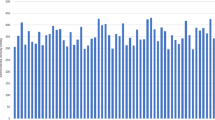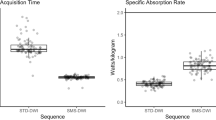Abstract
Purpose
To evaluate acquisition time and clinical image quality of a variable refocusing flip angle (vrf) single-shot fast spin echo (SSFSE) sequence in comparison with a conventional SSFSE sequence for imaging of liver lesions in patients undergoing whole-body PET/MRI for oncologic staging.
Methods
A vrfSSFSE sequence was acquired in 43 patients with known pancreatic neuroendocrine tumors undergoing 68Ga-DOTA-TOC PET on a simultaneous time-of-flight 3.0T PET/MRI. Liver lesions ≥1.5 cm with radionucleotide uptake were analyzed. Contrast-to-noise ratios (CNRs) were measured, and four blinded radiologists assessed overall image quality. Differences in repetition time and CNR were assessed using a paired Student’s t test with p < 0.05 considered statistically significant. Inter-reader variability was assessed with Fleiss’ kappa statistic.
Results
53 eligible lesions in 27 patients were included for analysis. vrfSSFSE demonstrated higher mean lesion CNR compared to SSFSE (9.9 ± 4.1 vs. 6.7 ± 4.1, p < 0.001). Mean repetition time (TR) was 679 ± 97 ms for the vrfSSFSE sequence compared to 1139 ± 106 ms for SSFSE (p < 0.0001), corresponding to a 1.7-fold decrease in acquisition time. Overall quality of liver lesion and common bile duct images with the vrfSSFSE sequence was graded as superior than or equivalent to the SSFSE sequence for 59% and 67% of patients, respectively.
Conclusions
Compared to conventional SSFSE, vrfSSFSE resulted in improved lesion contrast on simultaneous PET/MRI in patients with liver metastases. Due to decreased SAR demands, vrfSSFSE significantly decreased TR, allowing coverage of the entire liver in a single twenty-second breath hold. This may have important clinical implications in the setting of PET/MRI, where scan time is limited by the necessity of whole-body image acquisition in addition to bed specific imaging.



Similar content being viewed by others
References
Hicks RM, Yee J, Ohliger MA, et al. (2016) Comparison of diffusion-weighted imaging and T2-weighted single shot fast spin-echo: implications for LI-RADS characterization of hepatocellular carcinoma. Magn Reson Imaging 34(7):915–921
Reiner CS, Stolzmann P, Husmann L, et al. (2014) Protocol requirements and diagnostic value of PET/MR imaging for liver metastasis detection. Eur J Nucl Med Mol Imaging 41(4):649–658
Vitellas KM, Keogan MT, Spritzer CE, Nelson RC. (2000) MR cholangiopancreatography of bile and pancreatic duct abnormalities with emphasis on the single-shot fast spin-echo technique. Radiographics 20(4):939–957; quiz 1107–1108, 12.
Merkle EM, Dale BM (2006) Abdominal MRI at 3.0 T: the basics revisited. AJR Am J Roentgenol 186(6):1524–1532
Yang RK, Roth CG, Ward RJ, et al. (2010) Optimizing abdominal MR imaging: approaches to common problems. Radiographics 30(1):185–199
Bhosale P, Ma J, Choi H (2009) Utility of the FIESTA pulse sequence in body oncologic imaging: review. AJR Am J Roentgenol 192(6 Suppl):S83–93 (Quiz S4–7).
Semelka RC, Kelekis NL, Thomasson D, et al. (1996) HASTE MR imaging: description of technique and preliminary results in the abdomen. J Magn Reson Imaging 6(4):698–699
Fowler KJ, McConathy J, Narra VR (2014) Whole-body simultaneous positron emission tomography (PET)-MR: optimization and adaptation of MRI sequences. J Magn Reson Imaging 39(2):259–268
Sotoudeh H, Sharma A, Fowler KJ, et al. (2016) Clinical application of PET/MRI in oncology. J Magn Reson Imaging 44(2):265–276
von Schulthess GK, Veit-Haibach P (2014) Workflow considerations in PET/MR imaging. J Nucl Med 55(Supplement 2):19S–24S
Busse RF, Brau AC, Vu A, et al. (2008) Effects of refocusing flip angle modulation and view ordering in 3D fast spin echo. Magn Reson Med 60(3):640–649
Hennig J, Weigel M, Scheffler K (2003) Multiecho sequences with variable refocusing flip angles: optimization of signal behavior using smooth transitions between pseudo steady states (TRAPS). Magn Reson Med 49(3):527–535
Loening AM, Litwiller DV, Saranathan M, Vasanawala SS (2017) Increased speed and image quality for pelvic single-shot fast spin-echo imaging with variable refocusing flip angles and full-fourier acquisition. Radiology 282(2):561–568
Loening AM, Saranathan M, Ruangwattanapaisarn N, et al. (2015) Increased speed and image quality in single-shot fast spin echo imaging via variable refocusing flip angles. J Magn Reson Imaging 42(6):1747–1758
Levin CS, Maramraju SH, Khalighi MM, et al. (2016) Design features and mutual compatibility studies of the time-of-flight PET capable GE SIGNA PET/MR system. IEEE Trans Med Imaging 35(8):1907–1914
Hope TA, Pampaloni MH, Nakakura E, et al. (2015) Simultaneous (68)Ga-DOTA-TOC PET/MRI with gadoxetate disodium in patients with neuroendocrine tumor. Abdom Imaging. 40(6):1432–1440
Hope TA, Verdin EF, Bergsland EK, et al. (2015) Correcting for respiratory motion in liver PET/MRI: preliminary evaluation of the utility of bellows and navigated hepatobiliary phase imaging. EJNMMI Phys 2(1):21
Busse RF, Hariharan H, Vu A, Brittain JH (2006) Fast spin echo sequences with very long echo trains: design of variable refocusing flip angle schedules and generation of clinical T2 contrast. Magn Reson Med 55(5):1030–1037
Rosset A, Spadola L, Ratib O (2004) OsiriX: an open-source software for navigating in multidimensional DICOM images. J Digit Imaging 17(3):205–216
Coenegrachts K, Delanote J, Ter Beek L, et al. (2007) Improved focal liver lesion detection: comparison of single-shot diffusion-weighted echoplanar and single-shot T2 weighted turbo spin echo techniques. Br J Radiol 80(955):524–531
Hussain SM, De Becker J, Hop WC, et al. (2005) Can a single-shot black-blood T2-weighted spin-echo echo-planar imaging sequence with sensitivity encoding replace the respiratory-triggered turbo spin-echo sequence for the liver? An optimization and feasibility study. J Magn Reson Imaging 21(3):219–229
Phelps AS, Naeger DM, Courtier JL, et al. (2015) Pairwise comparison versus Likert scale for biomedical image assessment. AJR Am J Roentgenol 204(1):8–14
Kanematsu M, Kondo H, Goshima S, et al. (2006) Imaging liver metastases: review and update. Eur J Radiol 58(2):217–228
Ruangwattanapaisarn N, Loening AM, Saranathan M, et al. (2015) Faster pediatric 3-T abdominal magnetic resonance imaging: comparison between conventional and variable refocusing flip-angle single-shot fast spin-echo sequences. Pediatr Radiol 45(6):847–854
Adamic P, Babiy V, Janicki R, et al. (2009) Pairwise comparisons and visual perceptions of equal area polygons. Percept Mot Skills 108(1):37–42
Good WF, Gur D, Feist JH, et al. (1994) Subjective and objective assessment of image quality–a comparison. J Digit Imaging 7(2):77–78
Gur D, Rubin DA, Kart BH, et al. (1997) Forced choice and ordinal discrete rating assessment of image quality: a comparison. J Digit Imaging 10(3):103–107
Albaum G (1997) The Likert scale revisited: an alternate version. J Mark Res Soc 39(2):331–348
Blaikie N (2003) Analysing quantitative data. London: Sage Publications
Clegg F (1998) Simple statistics. Cambridge: Cambridge University Press
Jamieson S (2004) Likert scales: how to (ab)use them. Med Educ 38(12):1217–1218
Dietrich O, Raya JG, Reeder SB, et al. (2008) Influence of multichannel combination, parallel imaging and other reconstruction techniques on MRI noise characteristics. Magn Reson Imaging 26(6):754–762
Author information
Authors and Affiliations
Corresponding author
Ethics declarations
Funding
None.
Conflict of interest
T.A.H and S.S.V. receive grant support from GE Healthcare.
Rights and permissions
About this article
Cite this article
Hicks, R.M., Loening, A.M., Ohliger, M.A. et al. Variable refocusing flip angle single-shot fast spin echo imaging of liver lesions: increased speed and lesion contrast. Abdom Radiol 43, 593–599 (2018). https://doi.org/10.1007/s00261-017-1252-y
Published:
Issue Date:
DOI: https://doi.org/10.1007/s00261-017-1252-y




